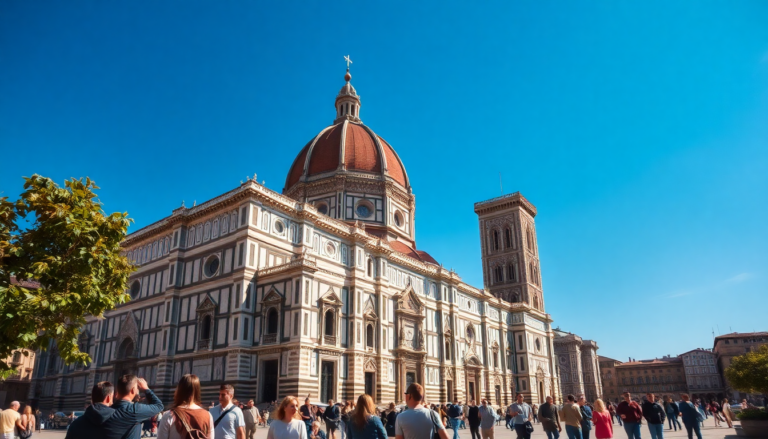Argomenti trattati
Picture stepping into a world where faith, art, and architectural genius intertwine, creating a visual feast for the senses. The Cathedral of Santa Maria del Fiore, with its awe-inspiring dome, stands not just as a place of worship but as a testament to the ingenuity of the human spirit. As you wander through Florence, it’s impossible to ignore the magnetic pull of this iconic structure, which has drawn countless visitors eager to experience its grandeur. But what lies beneath the surface of this magnificent cathedral? How did it come to embody the very essence of the Renaissance?
The heart of Florence: Santa Maria del Fiore
Located in the bustling Piazza del Duomo, the Cathedral of Santa Maria del Fiore is the centerpiece of Florence. As the city’s mother church, it holds significant spiritual importance while simultaneously showcasing the artistic aspirations of an entire era. Its towering dome, designed by the brilliant Filippo Brunelleschi, is so iconic that it has become synonymous with Florence itself. But the story of this cathedral is not merely about its physical attributes; it is steeped in a rich history that begins in the late 13th century.
It all started in 1296 when the renowned architect Arnolfo di Cambio laid the first stone. His vision was ambitious, intended to reflect the city’s growing power and prestige. Yet, like many grand projects of its time, the construction faced numerous challenges and delays, leading to a series of architects stepping in to bring the vision to fruition. Among them, Giotto, known for his exquisite craftsmanship, took on the task of building the bell tower, albeit briefly, before his untimely death.
The architectural evolution
The real transformation of the cathedral occurred during the 15th century, heralding the dawn of the Renaissance. It was a period marked by innovation, and the cathedral’s façade began to reflect this shift. Artists like Lorenzo Ghiberti and Filippo Brunelleschi emerged, pushing the boundaries of art and architecture. Brunelleschi’s daring design for the dome was particularly groundbreaking, as it eschewed the traditional wooden framework, instead relying on a double-shell structure that defied conventional engineering wisdom.
Imagine the excitement in the air as the dome was completed in 1436, becoming the largest in the world at the time. Standing 100 meters tall and with a diameter of 45 meters, it was a marvel that left spectators breathless. The colors of the marbles—green from Prato, white from Carrara, and red from Siena—further add to its splendor, creating a visual narrative that speaks to the artistry of the period. I can vividly recall my first glimpse of the dome; it was as if I was witnessing the dreams of an entire civilization materialize before me.
Inside the cathedral: A treasure trove of art
As you step inside the cathedral, the atmosphere shifts dramatically. The expansive interior, with its soaring ceilings and intricate details, invites contemplation. The three magnificent naves, supported by monumental pillars, lead the eye upwards toward the stunning frescoes that adorn the dome—masterpieces painted by Vasari and Zuccari, depicting the Last Judgment.
The floor, a mosaic of geometric designs, is a work of art in itself, drawing attention to the details that often go unnoticed. Add to this the forty-four stunning stained-glass windows, crafted by master artisans, filtering in light that dances across the interior, casting a divine glow. It’s an experience that transcends the mundane—a spiritual awakening, if you will. I remember feeling a sense of calm wash over me as I stood amidst the artworks that narrate stories of faith and humanity.
A place of reverence and reflection
Visiting the Cathedral of Santa Maria del Fiore is not just about admiring its beauty; it’s about entering a space that invites reflection. The twelve chapels, each housing significant artworks, tell tales of the saints and biblical figures who have shaped religious history. The intricacy of the sculptures, particularly those by Luca della Robbia, is a reminder of the devotion and skill that artists brought to their craft.
Even the sacristy offers a glimpse into the past, adorned with exquisite terracotta and wooden inlays, showcasing the artistry that flourished during the Renaissance. It’s easy to lose track of time here, absorbed in the details that speak volumes about the era’s cultural richness. Yet, while it’s open to all, visitors are reminded to respect the sacredness of the space—appropriate attire is required, and silence is often golden.
Plan your visit
The Cathedral of Santa Maria del Fiore welcomes visitors from Monday to Saturday, with access from 10:15 AM to 3:45 PM. On Sundays and religious holidays, the cathedral is closed to the public to accommodate liturgical celebrations. If you’re planning a visit, be sure to dress modestly—shoulders covered and skirts or shorts at an appropriate length. It’s a sacred space deserving of respect, and entering with the right mindset can transform your experience from mere observation to profound engagement.
As you stand before this architectural marvel, the tales of countless souls who have walked these grounds echo in your heart. The Cathedral of Santa Maria del Fiore is more than just a landmark; it is a symbol of Florence’s enduring spirit and a testament to what can be achieved when art, faith, and human ambition converge. Who knows? You might just leave with a little more than you came with—a sense of wonder that lingers long after you’ve departed.

